描述
顺序表我们可以把它想象成在一个表格里面填数据,并对数据做调整;

那我们的第一个问题是:怎么样在创建出足够的空间呢?
我们可以去堆上申请,用一个指针指向一块空间,如果申请的空间不够,我们可以再realloc申请出来。

我们的第二个问题是:怎么样标记我们用了多少空间呢?
这时我们就需要一个变量来记录我们当前的用到第几个“格子”(即用了多少空间),我们这里用size来表示:

我们的第三个问题是:怎么样知道我们有空间呢?
这时我们就需要一个变量来记录我们“格子”总数(即拥有多少空间),我们这里用capacity来表示:

所以(在.h文件中)我们线性表的结构体描述为:

typedef int SLDataType;
typedef struct SeList
{
SLDataType* a;
int size;
int capacity;
}SL;
组织
- 初始化
- 释放
- 尾插
- 尾删
- 头插
- 头删
- 指定位置删除
- 指定位置插入
- 查找指定元素
1.初始化
把我们描述出来的顺序表结构体里的变量初始化
在.h文件中:

因为要对创建出来的结构体里的内容进行修改,所以函数要进行传址调用;
在.c文件中:
我们用malloc来开辟空间,同时注意检查malloc;
因为我们刚刚开辟空间,并没有往顺序表里增删查改 所以此时size为0;
而我们的capacity就是在malloc开辟的空间大小。
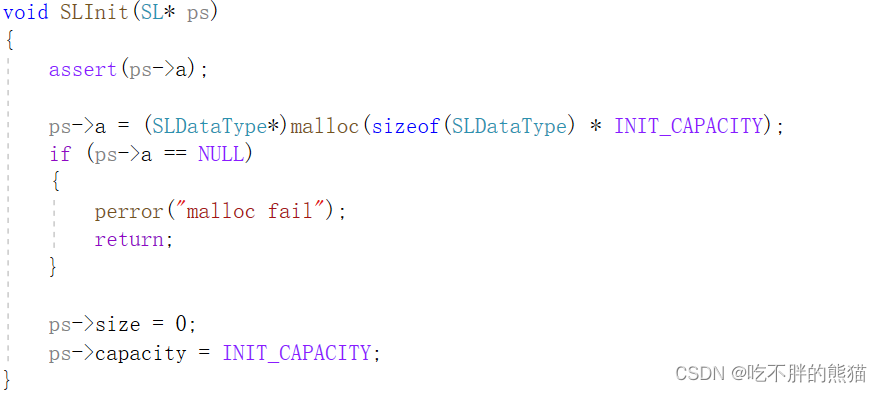
void SLInit(SL* ps)
{
assert(ps->a);
ps->a = (SLDataType*)malloc(sizeof(SLDataType) * INIT_CAPACITY);
if (ps->a == NULL)
{
perror("malloc fail");
return;
}
ps->size = 0;
ps->capacity = INIT_CAPACITY;
}2.释放
将描述出来的顺序表结构体里的变量逐个进行释放;
在.h 文件中:

在.c文件中:
首先是指针a,需要使用free函数将其释放,还需要注意的是free后,需要将a置空,避免出现野指针;
因为size和capacity是临时变量储存在栈上,函数调用结束后会自动释放,我们这里把它改为0就可以了。
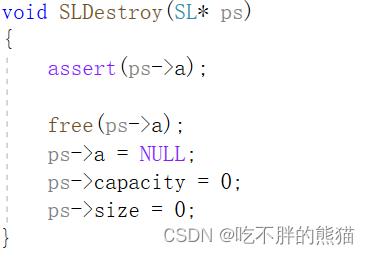
void SLDestroy(SL* ps)
{
assert(ps->a);
free(ps->a);
ps->a = NULL;
ps->capacity = 0;
ps->size = 0;
}3.尾插
向顺序表的尾部插入数据;
在.h 文件中:

在.c文件中:
尾插数据时,首先,需要判断capacity(空间)是否足够,如果不够需要扩容,这里我们写个扩容函数:
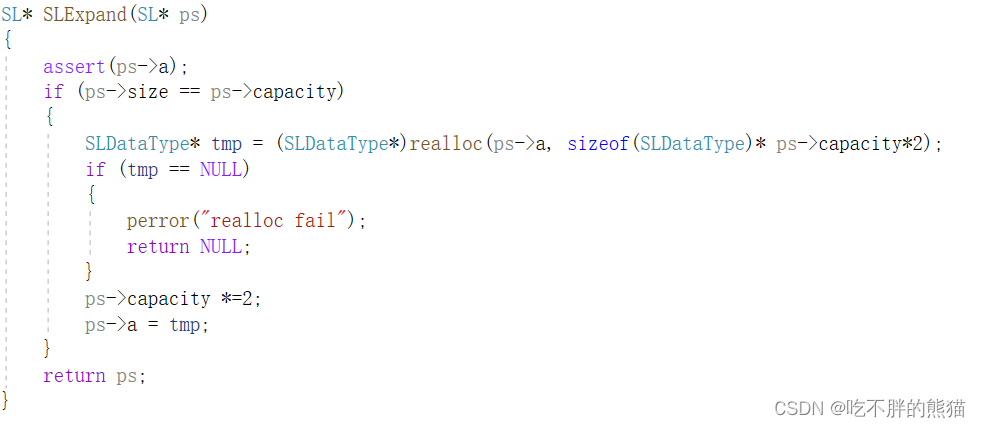
扩容我们用realloc函数,最后要返回ps至尾插函数判断是否为空;
接着,才能将数据尾插;
最后别忘了调整size的位置;
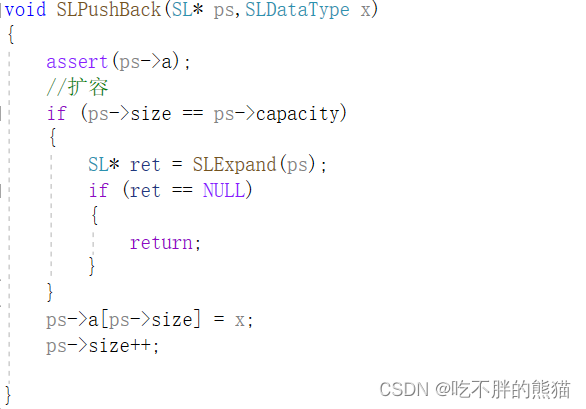
SL* SLExpand(SL* ps)
{
assert(ps->a);
if (ps->size == ps->capacity)
{
SLDataType* tmp = (SLDataType*)realloc(ps->a, sizeof(SLDataType)* ps->capacity*2);
if (tmp == NULL)
{
perror("realloc fail");
return NULL;
}
ps->capacity *=2;
ps->a = tmp;
}
return ps;
}
void SLPushBack(SL* ps,SLDataType x)
{
assert(ps->a);
//扩容
if (ps->size == ps->capacity)
{
SL* ret = SLExpand(ps);
if (ret == NULL)
{
return;
}
}
ps->a[ps->size] = x;
ps->size++;
}4.尾删
将顺序表的尾部删除;
在.h 文件中:

在.c 文件中:
因为顺序表是从开始连续存储size个数据,不能单独释放那一块区域,所以我们直接将size--就可以了,如果往后插入的话,就直接把数据覆盖;
assert()如果当capacity为空的时候还尾删时会报错,并且终止程序;
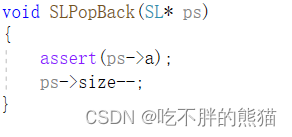
void SLPopBack(SL* ps)
{
assert(ps->a);
ps->size--;
}5.头插
向顺序表的头部插入数据;
在.h 文件中:

在.c 文件中:
首先,我们得先判断空间是否足够,如果不够就扩容;
第二步:把数据往后移一位,数据从最后一位开始向后移动;
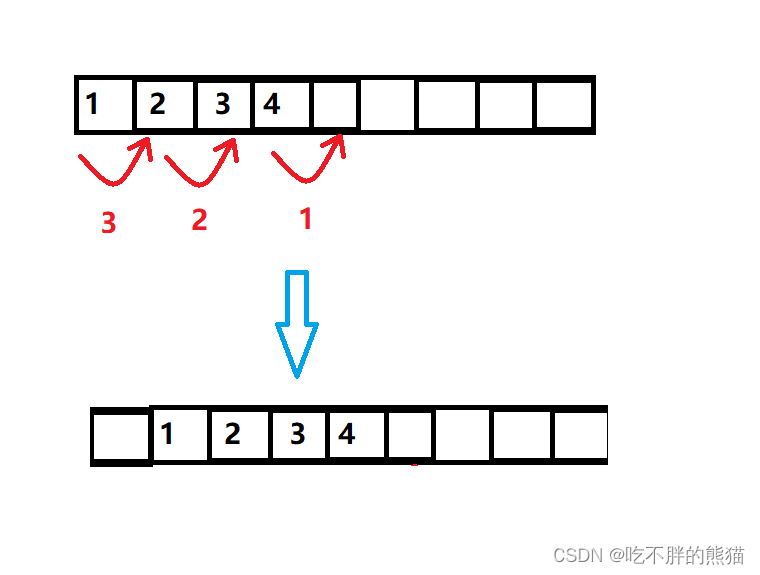
第三步:进行数据头插,别忘了把size的大小改改;
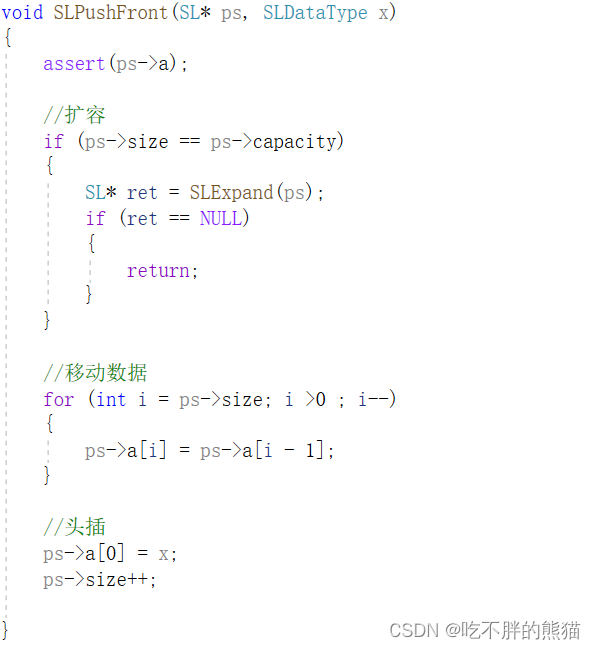
void SLPushFront(SL* ps, SLDataType x)
{
assert(ps->a);
//扩容
if (ps->size == ps->capacity)
{
SL* ret = SLExpand(ps);
if (ret == NULL)
{
return;
}
}
//移动数据
for (int i = ps->size; i >0 ; i--)
{
ps->a[i] = ps->a[i - 1];
}
//头插
ps->a[0] = x;
ps->size++;
}6.头删
将顺序表的头部数据删除;
在.h 文件中:

在.c 文件中:
我们只需要将从第二位数据开始往前移动,把前一位的数据覆盖就可以达到头删的效果;


void SLPopFront(SL* ps)
{
assert(ps->a);
assert(ps->size > 0);
for (int i = 0; i < ps->size; i++)
{
ps->a[i] = ps->a[i + 1];
}
ps->size--;
}7.指定位置删除
将顺序表的指定位置数据删除;
在.h 文件中:

在.c 文件中:
首先,要先用assert检查一下空间和pos的值是否合理;
如果删除的数据是最后一个就直接尾删;
如果如果删除的数据不是最后一个就需要移动数据覆盖,类似于头删;
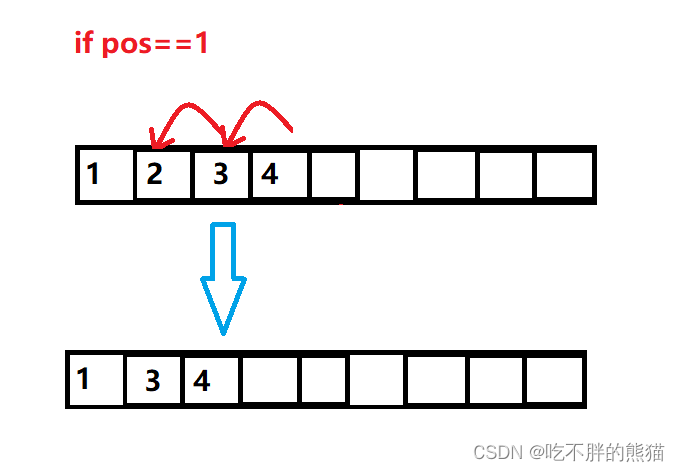

void SLErase(SL* ps, int pos)
{
assert(ps->a);
assert(pos >= 0&&pos<ps->size);
//如果pos是最后一个数据,尾删
if (pos == ps->size - 1)
{
SLPopBack(ps);
}
else
{
for (int i = pos; i < ps->size; i++)
{
ps->a[i] = ps->a[i + 1];
}
ps->size--;
}
}8.指定位置插入
将顺序表的指定位置数据插入;
在.h 文件中:

在.c 文件中:
首先,要先用assert检查一下空间和pos的值是否合理;
如果插入的数据是最后一个就直接尾插;
如果如果插入的数据不是最后一个就需要移动数据,再插入数据,类似于头插;
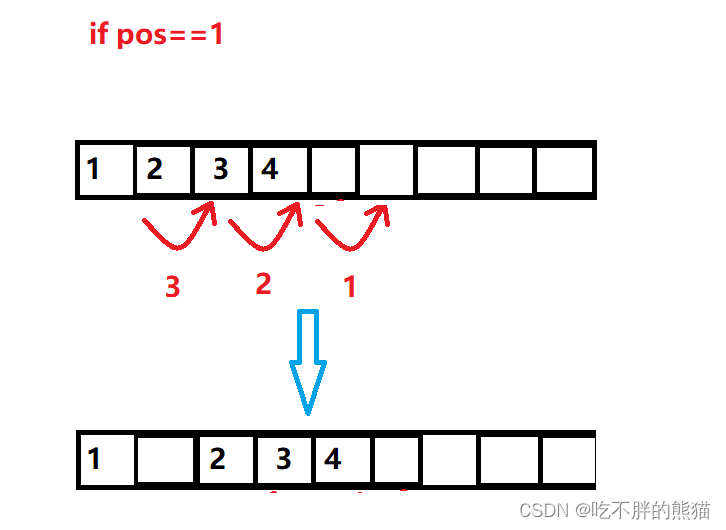
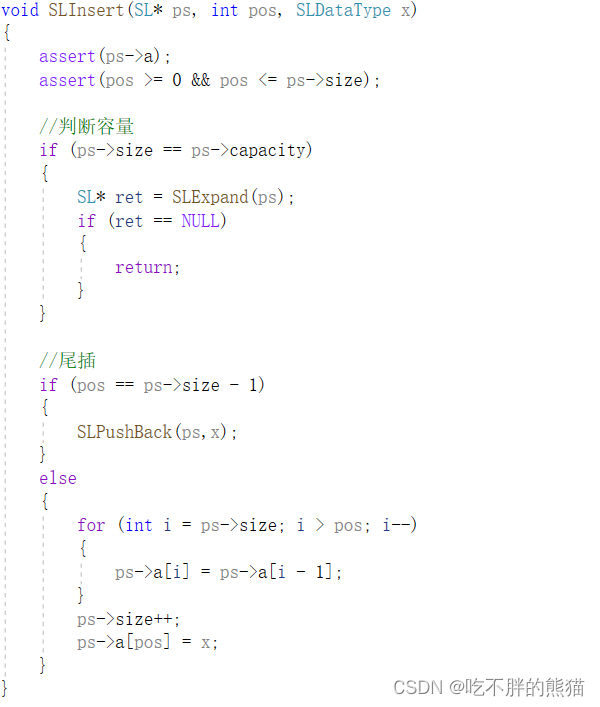
void SLInsert(SL* ps, int pos, SLDataType x)
{
assert(ps->a);
assert(pos >= 0 && pos <= ps->size);
//判断容量
if (ps->size == ps->capacity)
{
SL* ret = SLExpand(ps);
if (ret == NULL)
{
return;
}
}
//尾插
if (pos == ps->size - 1)
{
SLPushBack(ps,x);
}
else
{
for (int i = ps->size; i > pos; i--)
{
ps->a[i] = ps->a[i - 1];
}
ps->size++;
ps->a[pos] = x;
}
}9.查找指定元素
在顺序表中查找指定数据,并输出其下表,和在该表中的个数;
在.h 文件中:

在.c 文件中:
for循环遍历一下顺序表,如果遍历过程中找到了直接打印其下标,并用一个变量记录它出现的此数。
出循环后打印其和在该表中出现的个数。
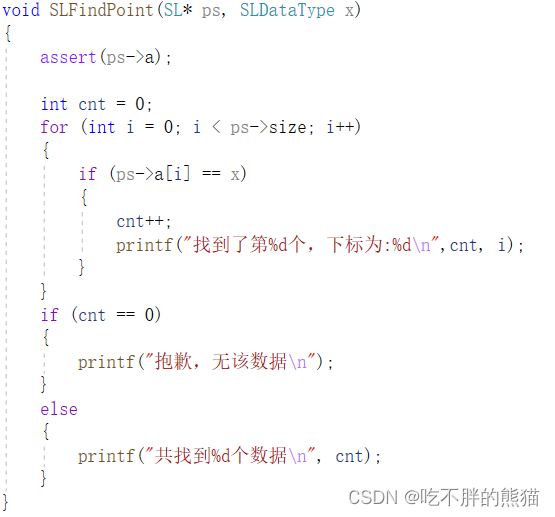
void SLFindPoint(SL* ps, SLDataType x)
{
assert(ps->a);
int cnt = 0;
for (int i = 0; i < ps->size; i++)
{
if (ps->a[i] == x)
{
cnt++;
printf("找到了第%d个,下标为:%d\n",cnt, i);
}
}
if (cnt == 0)
{
printf("抱歉,无该数据\n");
}
else
{
printf("共找到%d个数据\n", cnt);
}
}整个程序
.h文件:
#define _CRT_SECURE_NO_WARNINGS 1
#include<stdio.h>
#include<stdlib.h>
#include<assert.h>
#include<string.h>
typedef int SLDataType;
#define INIT_CAPACITY 4
typedef struct SeList
{
SLDataType* a;
int size;
int capacity;
}SL;
void SLPrint(SL* ps);
void SLInit(SL* ps);
void SLDestroy(SL* ps);
void SLPushBack(SL* ps,SLDataType x);
void SLPopBack(SL* ps);
void SLPushFront(SL* ps, SLDataType x);
void SLPopFront(SL* ps);
void SLErase(SL* ps,int pos);
void SLInsert(SL* ps, int pos, SLDataType x);
void SLFindPoint(SL* ps, SLDataType x);.c文件:
#define _CRT_SECURE_NO_WARNINGS 1
#include"Seqlist.h"
void SLPrint(SL* ps)
{
assert(ps->a);
for (int i = 0; i < ps->size; i++)
{
printf("%d ", ps->a[i]);
}
printf("\n");
}
void SLInit(SL* ps)
{
assert(ps->a);
ps->a = (SLDataType*)malloc(sizeof(SLDataType) * INIT_CAPACITY);
if (ps->a == NULL)
{
perror("malloc fail");
return;
}
ps->size = 0;
ps->capacity = INIT_CAPACITY;
}
void SLDestroy(SL* ps)
{
assert(ps->a);
free(ps->a);
ps->a = NULL;
ps->capacity = 0;
ps->size = 0;
}
SL* SLExpand(SL* ps)
{
assert(ps->a);
if (ps->size == ps->capacity)
{
SLDataType* tmp = (SLDataType*)realloc(ps->a, sizeof(SLDataType)* ps->capacity*2);
if (tmp == NULL)
{
perror("realloc fail");
return NULL;
}
ps->capacity *=2;
ps->a = tmp;
}
return ps;
}
void SLPushBack(SL* ps,SLDataType x)
{
assert(ps->a);
//扩容
if (ps->size == ps->capacity)
{
SL* ret = SLExpand(ps);
if (ret == NULL)
{
return;
}
}
ps->a[ps->size] = x;
ps->size++;
}
void SLPopBack(SL* ps)
{
assert(ps->a);
ps->size--;
}
void SLPushFront(SL* ps, SLDataType x)
{
assert(ps->a);
//扩容
if (ps->size == ps->capacity)
{
SL* ret = SLExpand(ps);
if (ret == NULL)
{
return;
}
}
//移动数据
for (int i = ps->size; i >0 ; i--)
{
ps->a[i] = ps->a[i - 1];
}
//头插
ps->a[0] = x;
ps->size++;
}
void SLPopFront(SL* ps)
{
assert(ps->a);
assert(ps->size > 0);
for (int i = 0; i < ps->size; i++)
{
ps->a[i] = ps->a[i + 1];
}
ps->size--;
}
void SLErase(SL* ps, int pos)
{
assert(ps->a);
assert(pos >= 0&&pos<ps->size);
//如果pos是最后一个数据,尾删
if (pos == ps->size - 1)
{
SLPopBack(ps);
}
else
{
for (int i = pos; i < ps->size; i++)
{
ps->a[i] = ps->a[i + 1];
}
ps->size--;
}
}
void SLInsert(SL* ps, int pos, SLDataType x)
{
assert(ps->a);
assert(pos >= 0 && pos <= ps->size);
//判断容量
if (ps->size == ps->capacity)
{
SL* ret = SLExpand(ps);
if (ret == NULL)
{
return;
}
}
//尾插
if (pos == ps->size - 1)
{
SLPushBack(ps,x);
}
else
{
for (int i = ps->size; i > pos; i--)
{
ps->a[i] = ps->a[i - 1];
}
ps->size++;
ps->a[pos] = x;
}
}
void SLFindPoint(SL* ps, SLDataType x)
{
assert(ps->a);
int cnt = 0;
for (int i = 0; i < ps->size; i++)
{
if (ps->a[i] == x)
{
cnt++;
printf("找到了第%d个,下标为:%d\n",cnt, i);
}
}
if (cnt == 0)
{
printf("抱歉,无该数据\n");
}
else
{
printf("共找到%d个数据\n", cnt);
}
}






















 2227
2227











 被折叠的 条评论
为什么被折叠?
被折叠的 条评论
为什么被折叠?










